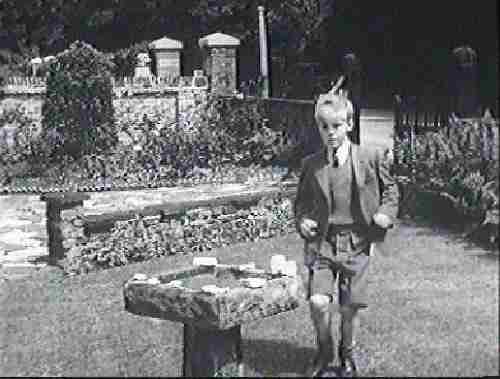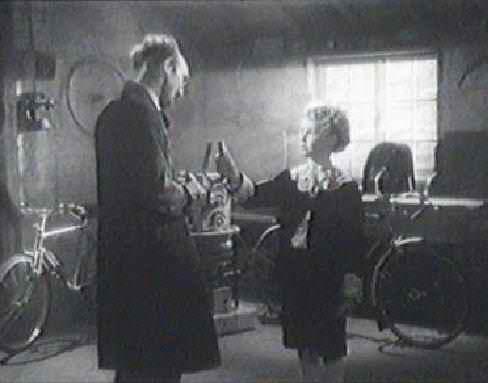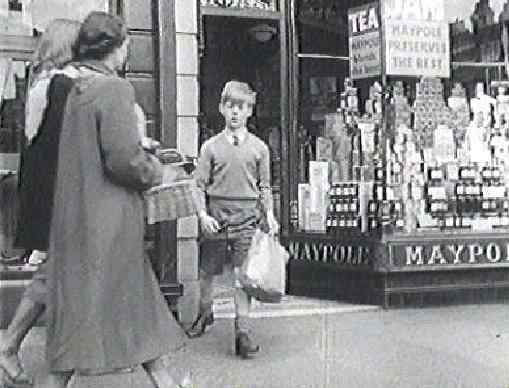
The Magnet (England, 1950)

Figure 1.--Johnny wears a grey short pants suit for much of the film, although he often takes his coat off. He was sent home from his boarding school and it is his school uniform. This and other outfits the rest of the cast wears would appear to be an acurate depictions to how the British dressed in the 1950s.
|
A British boy about 11 or so cheats a younger boy out of his magnet. The younger boy gets into trouble and the older boy is ashamed about it. He thinks the police are after him. His father can't figure out why his son keeps wearing shorts. He thinks the boy may be clinging to his childhood. The almost lyrical opening and closing sequences of this film have svhieved legendary status. The boys wears a typical outfit for the early 1950s, a short pants school unioform which he wears even after school. He appears briefly in a Little Lord Fauntleroy suit, as a kind of parody. This is one of many beautifully made British films during the post-World War II period. While wonderfully scripted and acted, unfortunately these films just could not compete with bop-o action of Hollywood films. One interesting aspect of the film is the use of actual outdoors scenes, giving a real life feel for Britain in the 1950s. The main Character, Johnny, is well palyed by William Fox.
Filmography
The almost lyrical opening and closing sequences of this film have achieved legendary status.
Setting
One interesting aspect of the film is the use of actual outdoors scenes, giving a real life feel for Britain in the 1950s. The film has a contemprary setting which is a small riverside town Lancashire,
England. The story takes place in Liverpool. The part of the city the boy lives is a village, but it had been absorbed by the sprolling metropolis. He lives near New Briton. This is a sea side place on the banks of the River Mersey, across the River from Liverpool's dock lands. After World War II no-one any longer thought this a good place to go for a weekly stay at the seaside. It is a wonderful document of how post-War England looked and people dressesd. There are scenes both at home and around town. One reviewer is toughed by the nostalgia and memories for post-War Liverpool: New Brighton Pier and Lido; Mersey Ferry and Dockland Overhead Railway; Blitzed Area of Liverpool below Anglican Cathedral; biscuits being delivered in large tin boxes.
Cast
The father, Dr. Brent is played by Stephen Murray and his wife is Kay Walsh. The main character is Johnny who is played by William Fox. Gladys Henson is Nanny. The younger boy, Kit, is Michael Brooke Jr.

Figure 2.--Obviously boys in the 1950s did not wear Fauntleroy suits. The charity worker was impressed when Johnny gives im his magnet. The Fauntleroy suit was a little joke and emphasizes the angel that the charity worker was depicting in his fund raising drive..
|
Johnny Brent who is about 11 or so cheats a younger boy out of his magnet. The younger boy trades a suposed "invisible clock" that goes "tick, tick" (the older boys makes the noise) when the younger boy holds it up to his ear. He thinks the younger boy is killed and feels terrible about it. He thinks the boys mum is after him because he recognises her while he is travelling on the Liverpool overhead railway. He over hears part of her
conversation and thinks the little boy has died because he cheated the boy out of his magnet. In fact what had died was the womans pet animal. Since he thinks the police are after him and his imagination runs wild. He feels terribly guilty, and it is the dramatitised depiction of his guilt that has given the film cult status. Johnny's guilt causes him to run away from home. First he tries to get rid of the the magnet but it comes back to him. Humour there because this same plot exists in lots of stories. Anyhow, eventually he gets rid of it by giving it to a man who is raising funds for a children'e charity. He thinks he's in terrible trouble. By this time the newspapers get wind of the story and the hunt is on to find the boy and give him the magnet back which the British found quite amusing. He thinks that he is being pursued because the boy he cheated has died and he is a bad boy. He runs for it and gets trapped in a Crawfords Cream Cracker deliver van. He ends up in the Liverp[ool dock area with a bunch of Street Urchins who tease him about the way
he speaks. However they respect him when he tells them he is a wanted 'Murderer.'
He rushes off
home. He is healed of his sadness and he is an happy 11 year old again. Eventually he wins a medal for bravery. Of course this means a great deal as it is an award showing a real accomplishment. Now he knows he is not a naughty boy any longer. The story has a happy ending for he meets the small boy again on the New Brighton beach. The small boy does not recognise him but plays the same trick on him by selling him an 'invisible' watch. (The joke here is about two wrongs do make a right.) The boy knows the younger boy is tricking him but is over joyed to be, as a British reader tells, us "squits in conmanship". [Ferguson]
Costuming
Many of the people seen in the film appera to be wearing their own clothes rather than costumes which combined with the actual outdoor settings rather gives the impression of a documentary This of course is very helpful when usingb suchb films to assess clothing styles. Presumably the main characters like Johnny did wear costumes. Johhny wears a typical outfit for the early 1950s, a short pants school uniform which he wears even after school. Sometimes he appears wearing his jumper and tie. His shorts are quite long in the style still popular in England during the 1950s. He has kneesocks, but rarely pulls them up. His father is a know-it-all psychologist, He has theory and an answer for everything. They are usually wrong. He can't figure out, for example, why his son keeps wearing shorts. He thinks the boy may be clinging to his childhood and he does not want to grow up. Mum cannot understand it.
The actual reason that the boy wants to wear short trousers is to avoid being recognised. A HBC reader reports, "I think the boy wore long trousers when he cheated the younger boy and thought the police would be looking for a boy in long trousers....hence his sudden desire to wear shorts again...I may be wrong.....otherwise there would be no reason for the boy to want them." Another reader explains, "In the early scenes the boy graduates to long trousers
but reverts back to short pants and it is somehow related to the contrick he played on the small boy. If I remember rightly. He gets into long pants and he is journeying into Liverpool on the overhead Railway. He over hears the boys mum tell about the death of a
pet, but thinks thy are talking about the boy he tricked. He also believes that this lady recognised him. He is trying to disguise his appearance by reverting back to short pants so that the woman will not recognise him. It is also another Ealing Film English Joke because the boy's dad is a child psychologist' whose interpretation of his sons behaviour is totally beyond what the truth is. It is also a statemant about the distant relationship of the boy and his dad." [Ferguson]

Figure 3.--The "Magnet" is a wonderful snapshot of what post-War England looked like and how people dressed--almost like a documentary film. Older British readers will remember shops like this before the appearance od supermarkets. Notice how Johnny's kneesocks are never pulled up.
|
The younger boy cheated out of his magnet appears in a classic Little Lord Fauntleroy suit. Obviously boys in the 1950s did not wear Fauntleroy suits. Presumbably this is the younger boy and his outfit desugned to make him look more innocent and vulnerable. A British reader writes, "The scene you write of with the boy wearing a Faultanroy outfit is in fact an 'Ealing Film' joke. It is an example of English humour and makes Northern people smile a little. Rowling's "Harry Potter" films are full of this humour but it does not pass over to
America because when I am in fits of laughter reading her story my American friends cannot for the life of them understand why I'm laughing. It does not seem funny to them. Likewise with other U.S. humour i don't get the joke! The Fauntleroy suit comes up in connection with the charity worker who uses what he thinks is the boy's 'generocity' to inspire the audiences to be generous givers. (I am now in fits of laughter! Sorry.) The charity worker speaks to a wide variety of people in different social classes, the pictorial images reflects the social class of the audience and the boy is wearing clothes to represent that section of
society and it is the supposed social class the 'generous' boy. Thus, the Faultainroy suit is the image shown while the charity worker speaks at a middle class fund raising event. The audience inspired by the story think the 'Little Boy' must be an angle to give his
magnet, the only thing he valued to a good cause. Thus wearing the clothes they associate with a caring boy. (By now I've stopped writing to wipe away my tears.)" [Ferguson]
Assessment
This is one of many beautifully made British films during the post-World War II period. While wonderfullyscripted and acted, unfortunately these films just could not compete with bop-o action of Hollywood films. William Fox
Reader Comment
A British reader tells us, "I first saw this film when I was about 9 and the scene
in the van and being lost in Liverpool scared me alot. Hope this helps.I hope you are able to appreciate the joke but I think you are American so might not be able
to see the humour!"
Sources
Ferguson, William. E-mail March 7, 2003.
HBC

Navigate the Boys' Historical Clothing Web Site:
[Return to the Main alpahabetic Maa-Mal movie page]
[Return to the Main English movie page]
[Return to the Main movie page]
[Introduction]
[Activities]
[Biographies]
[Chronology]
[Clothing styles]
[Countries]
[Topics]
[Bibliographies]
[Contributions]
[FAQs]
[Glossaries]
[Satellite sites]
[Tools]
[Boys' Clothing Home]
Created: August 28, 2001
Last updated: June 27, 2003





